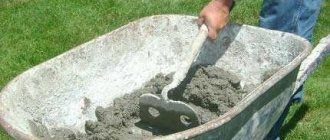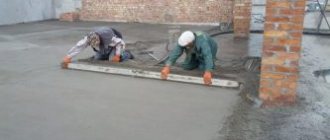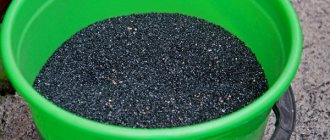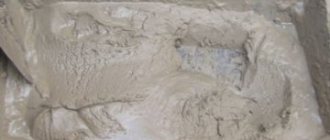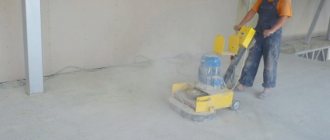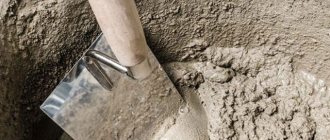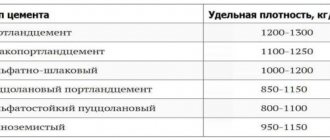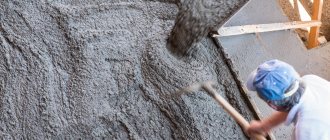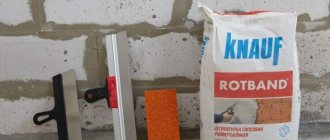Required ingredients and components
To make high-quality concrete, you need important substances such as sand or screenings, crushed stone or gravel, cement and liquid. Here are the required components:
- The most common cement among builders and ordinary workers is grade 500. It is sold in compact bags of 25 and 50 kg.
- For concrete, river sand without clay admixture is well suited, which can burst the concrete when the temperature changes.
- Granular substances of fraction 10 or 20 are perfect for filler; the smaller the better, since fine gravel or crushed stone is easier to mix.
- Water, as the last ingredient for concrete, must be tap water or fresh from a lake or river.
How to dilute cement m500 - its proportions for concrete must be carefully measured, since a violation in the proportions often causes its deformation. If you pour more cement into the mixture than required, the concrete will turn out weak and not durable.
How to determine the required proportions
In order to understand in what ratio the dry components need to be mixed, you need to decide on the purpose of the cement mortar. It should be borne in mind that the finished mortar, like dry cement, has its own brand corresponding to the brand of the selected building material. That is, the mortar used for laying M100 bricks must also be of the same brand. Only then is there a guarantee that the wall will be uniform.
Knowing the brand of the finished composition, it is very simple to calculate the ratio of sand to cement: the values of the grades of cement and mortar are divided, and the resulting result will be the correct ratio.
In order for the solution to be homogeneous and retain its strength after hardening, it is necessary to adhere to the following rules:
- the sand used must be pre-screened to separate all large fractions and prevent debris from getting into the cement mixture;
- the dry components of the mixture must be thoroughly mixed to achieve a homogeneous mass, because the strength of the cement solution after drying depends on the quality of the mixture;
- water should be added when all components have already been thoroughly mixed, the water consumption is, depending on the consistency of the finished solution, 1.5 - 2 liters per ten kilograms of dry mixture;
- When mixing the solution, water must be added in small portions, stirring. You should not add sand and cement to an already diluted solution - it will no longer be possible to mix them well, and this will affect the quality.
Attempts to change the proportions will not lead to anything good; if there is not enough sand, the mixture will set too quickly, and it is difficult to work with such a cement mortar. At the same time, increasing the amount of sand will make the finished joints in the brickwork insufficiently strong, and they will crumble.
How to make concrete, watch the video:
Construction and repairs always require cement, which must be mixed with sand in certain proportions. The resulting mixture has a strong viscous consistency, capable of bonding natural stone, bricks and even concrete blocks. Due to the fact that water is added to the solution, when dry, all building materials are firmly bonded to each other and form a single monolith.
Cement-sand mortar is used for laying bricks and ceramic tiles, pouring foundations, paths and plastering walls.
Before you begin the process of mixing all the components in the required proportions, you should know for what purposes it will be intended and what tools are needed for this work.
Cement dilution technique for concrete production
The most popular proportions for making concrete using M500 cement are the following ratios of cement, sand and crushed stone:
- Concrete grade 200 – proportions 1x3.5x5.6. The amount of concrete from 10 liters of cement is 62 liters.
- Concrete M300 – 1x2.4x4.3. Concrete yield – 47 liters.
- Concrete M400 – 1x1.6x3.2. The solution output is 36 liters.
The parameters indicated in the example are by weight and to produce, for example, grade 300 concrete, you need to take 10 kilograms of cement, 24 sand and 43 kg of crushed stone. Water is poured into the solution at the rate of ½ the mass of cement.
To get thick concrete, you should add less water, and if you need more fluid, then add more. But it should be borne in mind that a lot of liquid in concrete affects its strength: water evaporates from the structure over time and multiple small voids remain in its place.
There is one nuance that affects how to dilute M500 cement - if the bulk filler is dry, then the solution is diluted according to the standard proportion, but if the sand is wet, then slightly less water is added to the cement than according to ordinary ratios.
The solution at home for household needs without significant requirements for the characteristics of the screed can be prepared very frivolously. The “folk” technology for preparing mortar for floor screed creates a deliberately greater safety margin than is necessary. The specific composition for the floor screed in this case is also not critical. It can include a lot of different ingredients: gravel, crushed stone, sand, ASG, expanded clay, shavings, etc. And if it is made with minimal adherence to technology and proportions, it will last for many years.
Approximate ratio of cement and sand for the most common grades of cement.
Many people don’t really think about what kind of solution is needed to screed the floor. ...And the poured floor fulfills its functions. For this:
However, such an approximate technology does not guarantee the strength of the floor, the absence of cracking, etc. With a large amount of cement, the mortar is stronger, but it dries faster and is more difficult to level, and the final quality deteriorates. By increasing the amount of sand, the setting time increases, but the final strength decreases. Thus, by varying “by eye” you can make a significant mistake. It is better to follow the recommendations given by experts. But this is a “folk” technology without special requirements.
Ratio for installing plaster and pouring screed
The amount of water in this case can be very different, depending on the task. In this case, the mixture usually consists of cement and sand, diluted in proportions of 1 to 5.
As for the floor screed, an important factor here is strength, which must have a minimum threshold value of 10 MPa. In this case, it is best to select concrete grade M150, since this parameter in its case is 12.8 MPa. In general, the proportions of the mixture can depend on the following factors:
- The need to conceal various communications;
- The degree of leveling and raising of the surface.
You should immediately decide that when screeding floors in houses and apartments, it is best to use a solution of 100 or 150. In general, depending on the required brand of mortar and cement, the dilution parameters with sand may be as follows:
- Mortar 100, cement 200 – 1 part cement to 3 parts sand;
- Mortar 150, cement 300 – 1 part cement to 2 parts sand;
- Mortar 200, cement 300 – equal parts;
- Mortar 150, cement 400 – 1 part cement to 3 parts sand;
- Mortar 200, cement 400 – 1 part cement to 2 parts sand;
- Mortar 300, cement 300 – equal parts.
Important! Pay maximum attention to mixing the cement mortar for your needs. Incorrect proportions of components can compromise the strength of the poured structure. Especially when it comes to foundations, load-bearing structures or floor slabs.
Requirements for the solution
It’s a completely different matter when strict requirements are imposed on the base of the floor: static and dynamic loads, wear resistance, etc. The customer can also include in the contract a footnote to the requirements of SP 29.13330.2011 (previously SNiP 2.03.13-88).
In most cases, the screed is made on the basis of cement-sand mixtures (CPS). This is the most universal method. For floors made on the basis of cement mortar, fairly high operational requirements are met at minimal production costs. How to make a mortar for floor screed based on sand and cement, observing building regulations, will be discussed here. In the case of home preparation, the above rules can be followed approximately.
Basic requirements of regulatory documentation
- To level surfaces and cover pipelines, the compressive strength of the screed must be at least 15 MPa;
- For self-leveling polymer coatings – at least 20 MPa;
- The screed layer on top of various thermal insulation is at least 20 MPa;
- The thickness of the screed is at least 1.5 times the diameter of the maximum filler;
- Peel adhesion strength after 28 days is not less than 0.6 MPa. After 7 days, at least 50% of the design value;
- The compressive strength of porous screeds is at least 5 MPa.
To obtain the grade of solution, it is enough to multiply the value by 10 (i.e. 15 MPa corresponds to grade M150).
Factors affecting screed quality
In order of importance:
Ingredients
To make it at home, it is enough to use the first three components.
Proportions
They are determined first of all with the required brand of solution. It is better to focus on the maximum required amount of cement in the solution. The fact is that cement is the main binder. It is better to add it in excess than in short supply. In this case, errors in the quality of cement, inaccuracy in preparing the mixture (mainly errors with the addition of water), unfavorable features of strength development, etc. are leveled out.
The ratio of cement and sand in the screed mortar.
The brand of mortar is always calculated based on the binder, in this case cement. The density of cement is reduced by adding sand and the strength (the maximum pressure that the screed can withstand) is proportionally reduced. But the decrease in strength is not entirely linear and only up to a certain point. We present the share of the sand component for cements M400 and M500 for different grades of mortar.
Cement M400
- Solution grade M300 – 1.8;
- M200 – 2.5;
- M150 – 3;
Cement M500
- Solution grade M300 – 2.1;
- M200 – 3;
- M150 – 4;
For a high-quality screed, water in relation to cement in the solution should be 28 - 30%. With more water in the screed after drying, voids are formed, reducing the overall strength. With less water, the solution will be semi-dry, crumbly, the screed will not be monolithic and will have less strength.
But with the exact amount of water required, the solution turns out to be very hard, not flowable, and it is almost impossible to work with such a solution. For this purpose, plasticizers are added to the composition. Or they deliberately allow the strength of the screed to deteriorate, increasing the amount of water in the finished mixture from 40 to 70%. Those. if you count it in parts, you get from 1.1 (with cement grade M400 and mortar class B15) to 3.5 (with cement grade M500 and mortar class B12.5). At home, the strength is quite sufficient.
The most common combination (solution M300):
- Cement M400: 1;
- Sand: 2.5;
- Water: 1.4 – 2.4.
The required amount of water at home is determined by sampling.
Following this recipe, achieve a medium consistency of the mixture: not liquid and not dry. You can use a simple test at home. The solution should not run off the trowel, tilted at 45º. If there is little binder in the composition (including due to the poor quality of the latter), then the solution will not stick to the trowel, but will only slightly stain it. On the contrary, if it sticks strongly, then there is too much cement in the solution.
Advice! If you need repairmen, there is a very convenient service for selecting them. Just send in the form below a detailed description of the work that needs to be performed and you will receive proposals with prices from construction teams and companies by email. You can see reviews about each of them and photographs with examples of work. It's FREE and there's no obligation.
Cement is an inorganic substance with enhanced astringent properties, which is widely used in construction. The range of uses includes plastering, screeding, bricklaying, concreting, etc.
The severity of astringency depends on the brand of cement (“M”). In order to carry out the work correctly, it is necessary to take into account the brand of cement and the recommended proportions for diluting the solution.
Proportions of cement mortar for masonry, screed and concrete
Brick requires a slightly different ratio, so the 1 to 4 pattern is usually applied. In this case, M300 or M400 cement is used.
In some cases, to ensure greater plasticity and viscosity, slaked lime is added with a ratio of 0.25 to 1 cement.
You can test experimentally to obtain the desired consistency by placing the mixture on a plane with an inclination angle of 40 degrees. When the mixture flows, you need to thicken it somewhat, if it stays in place, then it turned out perfect.
The floor screed uses a standard proportion of 1 to 3. M400 cement is used. The amount of water added is slightly less than 50% of the volume of cement, but when laying a cement screed on the ground, you can pour an almost unlimited amount of water, the excess will go away on its own, help to perfectly level the floor and somewhat compact the surface.
In this case, if you draw a pattern on the mixture, it should gradually tighten. The preparation of concrete differs significantly due to the fact that it is needed in large quantities and increased strength.
Therefore, in addition to the main fillers, crushed stone or gravel should also be used. The proportion for preparation is 1 cement to 2 sand to 4 crushed stone or gravel.
For greater stability of the foundation, you can increase the amount of crushed stone by 1 or 2 parts.
Translating the patterns into numbers, it turns out that for 30 kg of cement it is necessary to use 60-90 kg of sand, 150 kg of crushed stone and about 30-40 liters of water.
In order to mix cement with sand efficiently, it is necessary to take into account the condition of the sand itself. Quite often it is collected illegally on beaches, and therefore does not undergo any processing.
Thus, the sand contains a large amount of debris; shells are not a problem, but debris, soil, roots and other organic matter can cause significant harm. first sift the sand
on a sieve with a mesh width of 3x3 mm.
Then pay attention to the color of the sand; if there is a dark shade, then it probably contains a lot of impurities of earth and dust. It is necessary to pour the sand into a container in advance and fill it with water. Stir it little by little and the debris will begin to float.
Currently, it is impossible to imagine any repair without the use of cement. all about the characteristics of M400 cement.
Sand is a loose mixture that is formed as a result of the destruction of various rocks under the influence of water. By clicking on, you will find out how much sand is in a ton.
Tile adhesive can be used to glue a wide variety of building materials in terms of properties and quality. full description of the composition of tile adhesive.
Then drain the water, you may have to repeat the procedure several times if the sand is very dirty. You should also check the consistency of the cement; it should not be lumpy. Normal consistency is considered homogeneous; if this is not the case, then the resulting lumps should be sifted and crushed.
Many experienced builders recommend adding liquid soap to the mixture. It increases the plasticity of the solution. In this way, cement should be diluted with about 100 ml of soap added to it. If it is necessary to create plaster in large layers, plasticizing additives can be added.
The advantage of this approach is that after application, the mixture is easily formed and hardens, which is difficult to achieve with a large layer of cement. Hardening means covering with a hard surface.
In construction, the approach is called "false grasp". Despite the visual hardness of the material, it hardens even longer than without the use of a plasticizer. False setting has a negative impact on the cement compaction process.
In small volumes the mixture dries quite quickly, but this is a negative factor. It is important that there is a gradual equalization of the amount of moisture in the cement. If it is too hot outside or indoors, the outside of the mixture is covered with a dried crust, and the inside is still wet cement.
Cracks may appear on the outside, which leads to deformation of the building. To prevent this effect, wet the surface using a spray bottle.
In general, the solidification of the solution is indicated by its lightening, so it becomes clear that the moisture has evaporated. Not everything is always so obvious, for example, a screed, especially one more than 20 cm deep, takes a long time to dry, even when it is not visually visible. To find out whether the screed has dried and to proceed with further work, you can use oilcloth.
Cover the screed overnight and check for condensation in the morning. In general, the screed mixture takes about 7 days to dry. After hardening, it must be taken into account that cement acquires full strength only after 30 days, provided that the average daily temperature is above 10 degrees.
At the moment of acquisition of final hardness, it is already possible to carry out other work, preferably not involving a strong deforming effect on the cement.
General information about the material
Cement is a binding agent that can be used either as part of a mixture or as part of a solution. It is needed for reliable fastening of building elements (walls, foundations, floors, finishing materials, etc.), due to which the structures become resistant to deformation and destruction.
Calculation of cement dilution is carried out taking into account several factors. Among them:
- Brand. This is a conditional indicator of the compressive strength of a material. Cement grade M50 has the minimum strength (used for plaster), the maximum strength is M600. There are also materials designated M-300, M-400, M-500. The choice of a specific brand is directly related to the purpose of cement use.
- Water. The final mixture or solution obtained by stirring will depend on the water that is added to obtain the desired consistency of the material. In this case, you can use snow, tap, rain water, etc.
- Filler. Calculation of proportions for dilution also depends on the fillers that form the mixture or solution. Can be used as fillers (sand and crushed stone of fine/coarse fraction, sawdust, slag, etc.).
- Special purpose. The proportions are influenced by the intended purpose of the material, that is, for what construction work the cement will be used. To lay the foundation, cement with maximum viscosity values (grades M-400/500/600) is used; for finishing work or plastering, it is customary to use grade M150, which will not damage the finishing materials when compressed.
If you need to figure out how to dilute cement, you can study the mixing recommendations. Additionally, recommendations for the use of specific grades of cement are taken into account:
- for the organization of brickwork, grades M-50/M-100 are used (often used for plaster);
- for finishing work, including plaster – grade M-50/M-100;
- for floor screed work – M100/M200 (with increased binding capacity);
- for concreting the foundation – M200/M300.
For cement mortars with sand, you need to take a grade of cement 2-3 times greater than the grade of mortar. For example, for a concrete foundation M200 you can use cement M-400/M-500.
A correctly selected ratio of cement mixture components is a guarantee of obtaining a high-quality result. Depending on the type of work, the proportions of fillers will change.
Proportions for finishing work
For plastering work, the optimal ratio is 1:3. This will require 1 part cement and 3 parts sand. The volume of water must correspond to the volume of cement. It is added in portions to achieve a uniform consistency and the desired thickness.
Brands such as M150/200 are used for plastering for interior finishing work. M300 cement is mainly used for finishing facades. To achieve maximum plasticity, lime can be used as an additive (from 0.5 to 0.7 parts per 1 part sand). This will allow a thin layer of the mixture to be evenly applied to the surface.
Proportions of fillers for brickwork
For such work, cement with high binding properties is used - M-300/M-400. The optimal ratio of components is considered to be 1:4. To increase the astringent effect, slaked lime is added to the mixture (0.2-0.3 parts of lime per 1 part of cement).
This filler makes the mixture plastic and easy to apply. Next, water is added to the dry mixture, and the consistency can be checked at an inclination of 40 °C. If the solution does not spread over the plane, this indicates optimal density.
Calculation of fillers for floor screed
When screeding floors, a ratio of 1:3 is recommended, and the optimal brand is M-400 cement. The calculation of water depends on the volume of cement - it should be ½ of its volume. Such proportions make it possible to obtain an M150 solution, which has a fairly liquid consistency.
Its minimal density allows it to fill voids (gaps and seams) on the floor surface. For work, it is recommended to use tools such as a spatula, a mixer (to mix the components of the solution), a trowel and a mixing container.
Proportions of fillers during concreting
Which cement is better for the foundation and for concreting in general? The calculation of proportions for such work is as follows: 1:2:4. This will require 1 part cement, 2 parts sand and 4 parts crushed stone (or gravel).
If you need to get concrete for laying the foundation of a house, then you need the M-500 brand of cement. In this case, the volume of water in relation to the dry mixture should be ½. This ratio of components will allow you to obtain B25 (M350) concrete.
If small volumes of concrete are required, the components can be mixed with a shovel; for mixture volumes of 2 m3 or more, a concrete mixer is usually used. Such a high bonding rate is not suitable for plaster, which will crack as the mixture dries.
Mixing foundation mortar
Preparing mortar for the foundation of a house is the most important process, since a properly mixed mortar will ensure the stability of the building, the absence of distortions and deformations, etc. You can mix cement yourself, selecting the proportions of fillers necessary for construction tasks.
However, you can also buy a ready-made mixture, where the ratio of components is determined according to construction purposes, but here it is important to know what kind of cement needs to be used so as not to make a mistake with the composition. It is correct to take into account the type of construction work and the volume of the final product when mixing fillers.
How to dilute cement with sand for a foundation
Mixing sand with cement
Concrete is the most popular material used in modern construction. It consists of several components: binder, water and filler (sand, crushed stone). The binding component is cement. The grade of concrete depends on its quality.
First, let's get acquainted with several general rules on how to dilute cement for a foundation and how to use materials correctly:
- to obtain a high grade of concrete, it is necessary not only to choose a high grade of cement, but also to increase its consumption and consumption
- You can’t do without tools: containers, shovels, concrete mixers (if large volumes)
- You need to add water to the finished dry batch gradually. As a rule, in practice, a smaller volume of liquid is poured than expected
- if the mixing is carried out in hot and dry weather, special additives are introduced into the solutions - clays, lime. Stone wall materials, blocks and panels in contact with the mortar are moistened with water
- the water must be clean. If it is not taken from a drinking water source, testing for impurities is required
- purchased materials must have a passport with the results of laboratory tests conducted by the enterprise
- You cannot add additional water or other components to an already set solution.
- at a temperature of +18 - +22 ° C, concrete will harden and acquire all its strength properties within 28 days
- The formwork can be removed only when the structure reaches 70% of its strength characteristics. Minimum period – after 1 week (in summer at an ambient temperature of 20 °C)
Choice of cement and proportions
The proportional ratios for concrete mortar depend on the type of future construction. How strong should it be, how wear-resistant and fire-resistant?
Having decided on the type of building and selecting the required brand of concrete for it, you need to choose a brand of cement.
| Required grade of concrete (according to the project) | Cement grades, under natural hardening conditions |
| recommended/acceptable | |
| M100 | 300 |
| M150 | 300/400 |
| M200 | 400/300, 500 |
| M250 | 400/300, 500 |
| M300 | 400/ 500 |
| M350 | 400/ 500 |
| M400 | 500/ 550, 600 |
| M450 | 550/ 500, 600 |
| M500 | 600/ 550, 600 |
| M600 | 600/ 550 |
The table shows a pattern that to obtain concrete M150, M200, M250, you need a binder with an indicator twice as high as the data (for 150 - 300, for 200 - 400).
The most common brands of binders for construction are M400 and M500.
If mixing is carried out manually, the main preparation proportions for each brand of concrete are:
when choosing the M400 cement brand -
- for M100 (or concrete class B7.5) - for 1 kg of dry cement there are 4.5 kg of sand and approximately 7 kg of crushed stone
- for M200 (B15) – per kilogram of binder – 2.7 kg of sand and 4.7 kg of crushed stone
- for class B22.5 (M300) - to 1 kg - 1.9 (parts of sand) and 3.7 (crushed stones)
- for M400 (B30) - for 1 kg of binder there is a little more than 1 kg of sand and 2.5 kg of filler
when choosing brand M 500 -
- M100 - 1:5.3:7.1
- M200 - 1:3.2:4.9
- M300 - 1:2.2:3.7
- M400 - 1:1.4:2.8
Selecting a cement brand
Example:
With this brand of cement M500, the bag weighs 235 kg. You need to obtain the concrete grade M300. This means 235 kg - 1. Sand required 1:2.2. We multiply 235 by 2.2, we get 517 kg. Crushed stone is needed 1:3.7 - with a similar calculation we get 869.5 kg. Water consumption depends on the moisture state of the sand, but the approximate proportion is 1: 0.5 (117.5 l).
If there are no tables: The approximate ratio of all dry components can be taken - 1: 3: 4. This means that 1 is cement, 3 is sand, 4 is crushed stone. But still, when constructing load-bearing elements and foundations, it is worth using calculated coefficients.
In the preparation of more durable concrete grades, cement consumption is increased. Attention is also paid to sand criteria. It is recommended to use river sand as a filler: it contains less clay and other impurities. But such sands have worse adhesion to the solution, since the surface of river sand grains is smooth. Gully sand, on the contrary, adheres well to the components, but requires preliminary washing.
The process of preparing the solution
- Calculation of proportions in kilograms or liters
- Dry ingredients are mixed. It is customary to pour them in layers:
Procedure for preparing the solution
- ½ sand,
- after ½ crushed stone (sifted)
- then the whole part of the cement
- adding crushed stone and sand.
If you have a concrete mixer, this dry mixture is mixed for 10 minutes. Manually takes longer.
- Water is gradually poured in in small parts. The solution should be viscous, but not too viscous. Usually a ratio of 1: 0.5 (amount of binder/water) is used. All this is constantly thoroughly mixed. The finished solution should look like thick sour cream.
If you can draw something on the surface of the mixture, and the drawing will not blur, but will only soften slightly, the solution is ready.
Important! The batch should be made in such a volume that it can be used within an hour. Concrete hardens over time, and when it is moved to a new place, it loses some of its future strength.
Compaction of the concrete solution in the formwork should be carried out every 10-15 cm of the layer. As a rule, the final layer is compacted until the cement “military” - tiny air bubbles on the surface - comes out. This will prevent cracks from forming.
What kind of cement is used for foundations?
For such important buildings as the foundation, a cement grade higher than M350 is used in construction. The most important thing is to pay attention to the weight, production date and shelf life of the cement for the foundation.
Worth remembering! Every six months of storage costs this material a quarter of the adhesive force in solution.
The material should be stored in a dry place; it is better to pack it on top of the factory shell with a polyvinyl chloride bag, so as not to end up with stone instead of cement at the start of construction.
stroykarecept.ru
Nuances of work
How to dilute cement for the foundation, and what brand is recommended to choose? To fill you will need:
- standard cement grade M-400 (for increased loads on the base - M-500);
- from 20 to 30 liters of water;
- 3 sandbags;
- crushed stone
Preparation of cement mortar (video)
Stages of work
The calculation of components is carried out 1:3 (one part M-400 to three parts sand). Such proportions are optimal not only for pouring the foundation, but also for screed or brickwork (plaster will require a weaker solution).
When laying the foundation, it is recommended to reduce the volume of sand to 2.5 bags; for the remaining 0.5 part, it is better to use crushed stone. Crushed stone will increase the load-bearing capacity of the foundation of the house, eliminating the risk of rapid destruction of the foundation and its deformation.
After the calculation has been made, the kneading procedure is carried out. To do this, you will need a metal sheet that will prevent dirt and debris from getting into the finished mixture.
If the volumes of the mixture are small, then buckets can be used as a mixing container. In this case, you can mix the components with a shovel. If the volume of solution exceeds 2 m3, then a special mixer is used to avoid the formation of lumps.
Water must be added in portions, bringing the solution to the consistency of thick sour cream. If the amount of crushed stone is exceeded, the mixture turns out to be liquid, and if sand predominates, it becomes too thick.
In the first case, when the mixture dries, voids may form, which will then lead to the destruction of the base. In the second case, when the concrete dries, it may crack.
You will need
- To mix cement or cement mortar you will need: cement, sand, clay, water, a large metal container or mechanical concrete mixer, a shovel, a garden hoe.
Instructions
Let's consider the most commonly used type of binding material - cement. It is the main element of mortars and various concrete mixtures. The positive qualities of cement are its strength and drying speed. Cement is divided into two types: aluminous and Portland cement. The characteristic features of alumina cement include: heat resistance, quick drying and high water resistance. This group is mainly used in industrial construction. For private construction, various brands of Portland cement are used. Cement grades are classified according to their strength when hardening and can be: low-grade - below 300, so-called ordinary - 300-400. Brand 500 belongs to the category of increased strength, and 500-600 to high strength. It is not difficult to visually determine the strength of cement. The darker it is, the stronger it is. In everyday life, all brands of cement are called cement, and high-grade cement (500-600) is called Portland cement. Peculiarities of cement marking: PC or M - Portland cement; D 0 - cement without additives; D 20 - cement containing 20% additives; B - fast-hardening cement; N - cement based on clinker of standardized composition (standardized cement); ShPC - slag Portland cement; PL - plasticization of cement.
To prepare cement, you need to find out for what purpose it will be used: for laying bricks, for pouring a path near a house, for plastering a wall. To lay bricks, you will need a solution in a ratio of 1 to 4, that is, you need to take and pour 1 bucket of cement and 4 buckets of sand into a container. Take a garden hoe and dry mix the ingredients in layers, stirring the mixture with the hoe every 5 centimeters. Stir until you get a homogeneous mixture. Then add a little water, stir, add water until the solution becomes viscous and sticky. Its consistency should be like thick semolina porridge. Now you can safely fasten bricks with it.
To prepare a solution for filling a garden path, make a solution with a ratio of 1 to 3, that is, 1 bucket of cement and 3 buckets of sand. Stir dry with a hoe, then add water until the solution is as thin as cream. Pour this solution into the pre-prepared formwork, breaking it into squares with thin boards. If you fill the path with one monolith, it will soon crack. After about 2 hours, prepare the laitance. To do this, take cement, add water to it until it becomes like milk. Pour this milk onto the path and spread it with a brush. This process is called “ironization”, the track will become gray-green and very strong on the surface. To plaster the walls, it is enough to make a solution of 1 to 5 with the consistency of liquid semolina porridge.
The main component of most building mixtures is cement; its grade, quality and activity have a direct impact on the main performance characteristics: strength, setting time, crack resistance, moisture and frost resistance. This binder is recommended to be mixed with sand in strict adherence to proportions, which in turn depend on the purpose of the composition. Properly prepared cement mortar has a homogeneous structure without lumps, unmixed dry areas, does not delaminate (except for heavy concrete) and remains plastic for 1 hour.
Features and nuances of breeding
To obtain a high-quality mixture or concrete, a number of requirements are met:
1. Only fresh binder is used. Portland cement, with or without additives, begins to lose activity after 2-3 months; after six months, its strength grade decreases even in packaged form. It is not recommended to mix fresh and crumpled or wet cement.
2. Sand and other types of filler are pre-prepared: washed to remove silt, dried, and sorted for large debris. When mixing small volumes of plaster or leveling compounds, it is recommended to mix sand and cement taking into account the selected proportions and sift them together.
3. All compositions can be diluted exclusively with clean water: from the water supply or collected precipitation. It is not recommended to use water from external sources due to possible siltation.
4. Cement and sand are combined without delay or pre-soaking. The recommended sequence of adding components depends on the mixing method. When using mixers or mixers - from the smallest grain to crushed stone (liquid is poured in first, then the size of the poured fractions increases), simultaneous input of binder and sand is allowed. When kneading by hand, all ingredients are first mixed in a container in dry form, then they should be diluted with water - thoroughly, in small portions, within the selected W/C ratio.
5. Mix the components until the air bubbles are completely expelled, but no longer than 15 minutes.
6. Plasticizers and similar additives require caution. Some of them (liquid soap, lime) must be diluted with water in advance, others are introduced in the last minutes of mixing. When using dissolvable impurities, it is important to leave some water for them from the total dose. It is not recommended to exceed the selected W/C ratio in any case.
To mix manually, you should choose a large container; diluting the ingredients in it will be easier. But the best results are achieved when using construction mixers or concrete mixers; the former are recommended when preparing small portions, the latter when working with concrete. Tools with a high speed of revolutions are not required; due to the rapid setting of cement, this is fraught with its overuse.
Preparing concrete: proportions in buckets
First, pour cement and sand sifted through a sieve with a mesh size of 3x3mm and mix this mixture thoroughly until the mixture is homogeneous.
If the sand is very dirty, then soak and mix it in water, then drain the dirty water and dry the sand in a warm place. Then add in portions measured clean cold water, preferably rain or snow, which is free of impurities and constantly mix the solution until the consistency of thick sour cream is obtained.
One of the criteria for the correct thickness of the mixture: it must adhere to a trowel or spatula. Let us remember that the prepared solution is viable for up to 1.5 hours and must be completely used within this period of time. So, we have decided on the dishes and answered the question of how to properly dilute cement. Before mixing cement, you need to prepare a container where you will do this, and a hammer drill with a mixer attachment.
This is for small quantities of mortar for minor repair work. If you have serious construction projects, for example, pouring a foundation, then you will need both a large container and a mortar mixer. You can use a bucket as a measuring container. First of all, sand is measured and poured in a heap, then the required amount of cement is added. Do not add water before mixing the components.
Everything is mixed dry. After obtaining a homogeneous dry mixture, we begin to add water to it and mix the materials into a thick, homogeneous mass. Some do it differently. They mix cement with water and then add sand. There is no big difference as to who is more comfortable. When pouring a floor or foundation, crushed stone is added to the cement. The proportions of cement, crushed stone and sand will be as follows - Accordingly, one part of cement should be mixed, and two parts of crushed stone and sand. Crushed stone is needed to make the concrete monolith even stronger.
If you need to make concrete for pouring a foundation, then use Portland cement marked M. For plaster, light grades of cement marked less are suitable. Sand is used clean, river sand, without clay.
Breeding Features
What is the dissolution technology? There is a specific scheme for this. To mix the cement mortar used for brickwork, you need to have the following components available:
- sand;
- cement powder;
- water;
- additives.
How to dilute cement in this situation? The first step is to mix the main bulk substances (sand and cement powder) together.
To do this, you can use a container made of metal or plastic. Preferable.
The cement along with the sand must be sifted through a sieve in advance and then mixed thoroughly. After this, the required volume of clean water is added. It is advisable to take tap water. It should not contain a lot of minerals and salt. As for the proportion of components, it depends on the brand of the required solution and the brand of powder.
It is best that the brand of the masonry mixture matches the brand of the material used (brick). If raw materials of grade 400 are available and it is necessary to make a working mixture of grade 200, then the ratio of cement to sand is 1:2. To obtain a solution of 100, the proportion will be 1:4. Water is added at the end to obtain a homogeneous mass. It shouldn't be liquid. To properly dilute cement in this situation, use an inclined plane with an angle of 45%. If the mass made does not flow down it, then its consistency is optimal. To improve the quality of the solution, you can add detergent or special additives to it. Another sequence is often used when diluting cement: first pour out water, then detergent, half the sand, powder, the rest of the sand mixture and then liquid again.
Return to contents
Preparation of cement-lime mixture
How to dilute cement to obtain a mixture for plastering? A good mortar includes cement powder, sand, lime and water. First you need to make a dry mixture. To do this, mix cement with sand. Their ratio is 1:5. The next step is adding lime milk. It is done quite simply. To do this, lime is dissolved in water. Most often, M-400 powder is used to mix the plastering solution. To obtain a high quality mixture, the cement powder must be friable. The resulting plaster mixture is excellent for concrete or wooden surfaces.
However, the ratio of cement, lime milk and sand may vary depending on what they will be used for. The following ratios are most often taken: 1:2:9 and 1:1:6. If finishing of cornices is organized, then the proportion of cement and lime is 1:6. In the case of finishing brick, wood or concrete surfaces, the ratio of these components is 1:2. During the process of diluting the powder, the cement-sand mixture does not fall out to the bottom, as is observed during the mixing of cement-sand mortar.
Return to contents
How to dilute cement to make concrete?
How to dilute cement correctly if you need to get concrete? If in the previous case only Portland cement, sand and water were used, then concrete requires another important component - crushed stone or gravel. This is a coarse filler that serves to increase the strength and rigidity of the mixture. To dilute the main bulk substance, you can use a manual or mechanized method. In the latter case, you cannot do without a concrete mixer. With its help, you can avoid obtaining a heterogeneous mass. It is known that when preparing concrete, you first need to mix sand and powder and only then pour in crushed stone and pour in water. If this condition is not observed, lumps may form.
Cement powder must be diluted according to certain proportions. If M-400 cement is available, then to obtain grade 300 concrete, the ratio of cement, sand and crushed stone should be 1:1.9:3.7. If you use M-500 brand powder instead, the proportion will look different: 1; 2.4: 4.3. The main ingredient must be diluted until the mixture resembles sour cream.
Return to contents
Water cement ratio
When diluting cement powder, an indicator such as the water-cement ratio is of no small importance.
It determines the fluidity of the future mixture and its strength. When mixing concrete, the amount of water must be accurately measured. Experienced builders know that for normal hardening of concrete or cement mortar, it is enough for water to make up about a quarter of the total mass of the mixture. But this will lead to difficulties when laying concrete. The water-cement indicator depends on the brand of cement powder used and the required quality of concrete. To obtain concrete grade 300 in the presence of M-500 cement, this figure is 0.56. It is of great importance that this indicator may vary depending on what raw materials are taken. If wet sand containing a large amount of moisture is used, the concrete may turn out to be more liquid.
Filler ratio
The main measure is the proportion of binder. Depending on the purpose of the composition, the following proportions of the introduced components are used:
1. To prepare plaster: 1:3, W/C ratio does not exceed 1, it is recommended to dilute the composition in portions. When carrying out work indoors, the minimum strength grade of cement is M150, for facades - M300. To impart plasticity to the plaster, it is allowed to introduce lime (no more than 50% of the proportion of sand).
2. When mixing masonry mortar: 1:4, binder strength grade is not lower than M300. Lime is introduced exclusively in slaked form and no more than 0.3 of the share of cement. The ideal W/C ratio is within 0.5; to add plasticity, add 50 g of liquid soap. Masonry compositions are prepared in strict sequence: first, water is introduced into a container or concrete mixer, then fillers.
3. For foundation work: 1:2:4 (cement, sand, crushed stone, respectively), the proportion of water is taken equal to the volume of binder. Portland cement from M400 and coarse filler from hard rocks are used, mixing is carried out in a concrete mixer.
4. When pouring a concrete floor screed, it is necessary to dilute high-grade cement with sand in a ratio of 1:3, with a W/C ratio of 0.5. The composition should follow the trowel and fill small voids; it is better to knead it by force.
5. When ironing floors, a mixture of cement and sand is prepared in a 1:1 ratio. Liquid glass or lime should be diluted in water in advance, at a ratio of no more than 0.1 to the proportion of binder.
When preparing concretes and compositions with various fillers, cement is introduced into the solution without mixing with sand; in all other cases, it is advisable to sift them together. In addition to pouring clearly measured shares, the correctness of the proportions is determined by the brand of binder (not lower than the required one; if there is any doubt about the quality or freshness, its consumption is increased), the cleanliness and dryness of the sand, the strength and flakiness of the crushed stone (for concrete). The most difficult thing is to choose the water-cement ratio; it is recommended to first use 85% of water, then gradually introduce the rest.
The question often arises: how to dilute cement with liquid soap. This additive is very popular in private construction; it is the cheapest plasticizer. But excess foam is harmful; it is better to wait 3-4 minutes for it to shrink and only then introduce the cement-sand mixture (and in small portions). This increases the kneading time by about 5 minutes. The total proportion of any impurities (including coloring minerals) should not exceed 10% by weight of the binder, otherwise the quality of the prepared solution is sharply reduced (adhesive properties are leveled).
Expert advice
It must be diluted at an ambient temperature of +5 °C. If possible, use a concrete mixer, this increases the homogeneity and quality of the solution. With automatic mixing, the sequence of loading components depends on the size of the fractions: from small to large. The finished solution is unloaded and used immediately; the higher the cement strength grade, the faster it sets. To improve performance it is recommended:
- introduce frost-resistant or hydrophobic additives (relevant for concrete);
- when mixing plaster, replace part of the sand with perlite (to increase heat-insulating properties);
- make a test batch to check the quality of the components;
- If possible, use special dispensers.
The most common material, without which almost no construction work can be done, is one of the types of cement mixture - concrete. An irreplaceable component of concrete is cement.
The future strength of the foundation, the reliability of road surfaces, and the quality of brickwork and plastering depend on whether the cement mass was mixed correctly.
Surely, each of us has encountered concrete work at least once in our lives. Not everyone succeeded in preparing concrete mortar the first time, so you can often come across the following questions: “How to dilute cement without sand? What proportions of sand and cement should be observed? What is the solution consumption per 1 m 2? etc.
So let's look at these nuances together.

